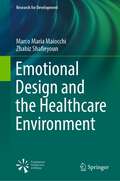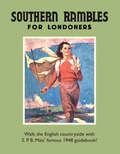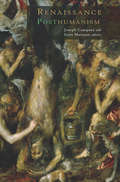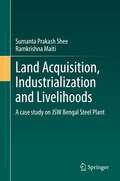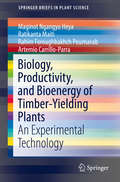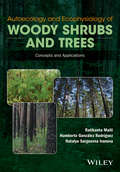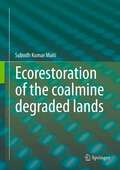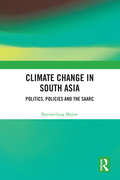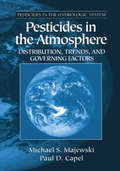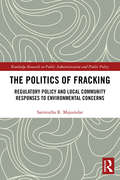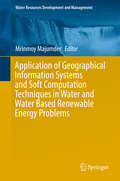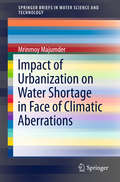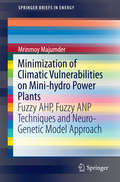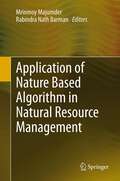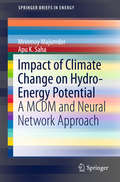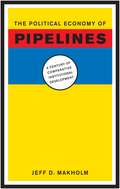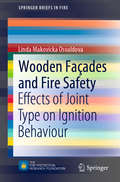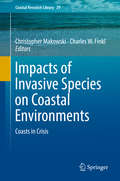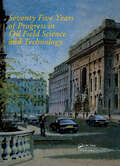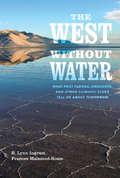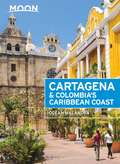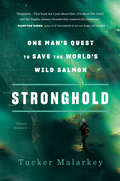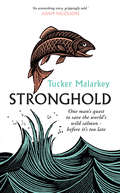- Table View
- List View
Herbal Homekeeping
by Sandy MaineIf you're alergic to the abrasive cleaners on the market today, or if you just want to be more environmentally concious, chedk out this book on how to make your own all-natural cleaners for the home, garage, and barn.
Emotional Design and the Healthcare Environment (Research for Development)
by Marco Maria Maiocchi Zhabiz ShafieyounFor all of the tremendous advances in medicine and treatment the world has seen in the modern era, the human body’s ability to heal itself remains a (literally) vital and often overlooked facet of healthcare. Through the use of emotional design, aimed at transforming healthcare environments, such as waiting rooms, in such a way as to boost the emotional wellbeing of patients, and thus their general attitudes, including in regard to their own healing processes, medical institutions can improve outcomes for the people they treat while simultaneously lowering overall costs. Design, as an inherently transdisciplinary, problem-solving activity, is well-suited to this task. And when combined with a field of study such as neuroscience, which can literally map out the perceptions that lead to the experience of particular emotions, healthcare environments can be transformed into spaces (through such innovations as Kansei engineering) that then subsequently transform the people who rely on them the most, leading to more efficiency and less red ink.
Southern Rambles for Londoners
by S. MaisIn 1948 with post-war Britain's sense "dulled by traffic and by bombs", this pocket-sized book was a clarion call for readers to rediscover the beauties of the idyllic English countryside. Published by Southern Railways, it recounts the joys of listening to birdsong, picking whortleberries, gazing at the clouds and "being genial" in the bars of tiny village inns - experiences that had been obscured by war, deprivation and the bus and train journeys that suburbanization had brought. Offering twenty real country walks around Surrey and Kent, this guide reveals where the 1940s rambler would be "most likely to find quietude and loveliness" - as well as the best cakes!
Renaissance Posthumanism
by Scott Maisano Joseph CampanaConnecting Renaissance humanism to the variety of “critical posthumanisms” in twenty-first-century literary and cultural theory, Renaissance Posthumanism reconsiders traditional languages of humanism and the human, not by nostalgically enshrining or triumphantly superseding humanisms past but rather by revisiting and interrogating them. What if today’s “critical posthumanisms,” even as they distance themselves from the iconic representations of the Renaissance, are in fact moving ever closer to ideas in works from the fourteenth to the seventeenth century? What if “the human” is at once embedded and embodied in, evolving with, and de-centered amid a weird tangle of animals, environments, and vital materiality? Seeking those patterns of thought and practice, contributors to this collection focus on moments wherein Renaissance humanism looks retrospectively like an uncanny “contemporary”—and ally—of twenty-first-century critical posthumanism.
Land Acquisition, Industrialization and Livelihoods: A case study on JSW Bengal Steel Plant
by Ramkrishna Maiti Sumanta Prakash SheeThis book provides an assessment of the impacts of human intervention on the natural environment and peoples' livelihoods through land-use conversion due to industrialization. Problems of land acquisition and the execution thereof have varying consequences that depend on the specific geographical as well as socio-political contexts in which they occur. This book covers a specific study of JSW Bengal Steel Ltd., which in 2014 planned to set up a 10.0 million ton per year integrated steel plant at the upper catchment of Sundra basin, the tributary of the Shilabati that ultimately pours to the river Rupnarayan, located at Salboni Block of Paschim Medinipur, West Bengal, India. The project was ultimately put on hold, but caused many lingering environmental and socioeconomic problems due to the acquisition of formerly productive lands. The book examines this case to generate a database on the different aspects of land acquisition and its negative impacts on the geomorphology and hydrological of non-timber forest products, agricultural impacts resulting in livelihood changes, policy dimensions of land acquisition, and the impacts of delays in project implementation through a comparative analysis between projects-affected areas and non-project areas. The book will appeal to environmental managers and industry workers, as well as students and researchers in environmental economics, anthropology, and human geography.
Biology, Productivity and Bioenergy of Timber-Yielding Plants: An Experimental Technology (SpringerBriefs in Plant Science)
by Ratikanta Maiti Maginot Ngangyo Heya Rahim Foroughbakhch Pournavab Artemio Carrillo-ParraFace to the current global energy crisis, there is an urgent necessity of searching for alternatives to fossil fuels, and this book shows how timber is a promising resource for sustainable energy production. Northeast Mexico represents an important forest resource to satisfy the needs of the population in these areas. In order to harness these forest resources, technology for exploring these valuable resources must be developed. These technologies (with special reference to biology and wood technologies) are available in scattered form in a few books but there is no central, comprehensive source for practical forest scientists for adopting efficient forest management, practice, and exploration. This book deals with the characterization of the vegetation, morphology, phenological development, biomass production (leaf, litter, wood), and bioenergy of some timber-yielding species of Northeast Mexico, which will serve as a guide to study timber-yielding plants in the native vegetation of Tamaulipan thornscrub and experimental plantations. This includes morphology, vegetation cover, biomass production in terms of volume leaf biomass, litter, and volume of fire wood and timber. Special emphasis is given to the estimation of bioenergy products and chemical composition (Ph, extractable lignin, and inorganic elements). Large variations exist in vegetation cover, morphology, phenological development, biomass production of leaf and litter, volume of wood and various variable of bioenergy products among the selected species. The maximum production was found in summer and the volume of the harvestable timber was obtained in experimental plantations. This book, therefore, will serve as a practical handbook to characterize timber-yielding plants, which will help to efficiently manage forestry resources.
Autoecology and Ecophysiology of Woody Shrubs and Trees: Concepts and Applications
by Ratikanta Maiti Humbero Gonzalez Rodriguez Natalya Sergeevna IvanovaForest trees and shrubs play vital ecological roles, reducing the carbon load from the atmosphere by using carbon dioxide in photosynthesis and by the storage of carbon in biomass and wood as a source of energy. Autoecology deals with all aspects of woody plants; the dynamism of populations, physiological traits of trees, light requirements, life history patterns, and physiological and morphological characters. Ecophysiology is defined by various plant growth parameters such as leaf traits, xylem water potential, plant height, basal diameter, and crown architecture which are, in turn, influenced by physiological traits and environmental conditions in the forest ecosystem. In short, this book details research advances in various aspects of woody plants to help forest scientists and foresters manage and protect forest trees and plan their future research. Autoecology and Ecophysiology of Woody Shrubs and Trees is intended to be a guide for students of woody plant autoecology and ecophysiology, as well as for researchers in this field. It is also an invaluable resource for foresters to assist in effective management of forest resources.
Ecorestoration of the coalmine degraded lands
by Subodh Kumar MaitiThe book adopts an application-oriented approach for ecorestoration of coalmine degraded. The theoretical aspects of ecorestoration, and steps involved in ecorestoration process and experimental aspects of thorough analytical procedures have been discussed in detail. It emphasizes on the types of mining, land degradation, and biodiversity conservation while giving details of technical and biological steps, topsoil management, selection of plant species, seeding, nursery practices; adoption of innovative approaches like mulching, biofertlizer application, hydroseeding, superabsorbent; use of grass-legume mix; monitoring and aftercare of reclaimed sites; the indicators of sustainable ecorestoration; and Rules and Acts implemented and followed across the world. Best ecorestoration practices, mine closure issues, collection, laboratory analysis and interpretation of minesoil and topsoil samples, monitoring biological parameters, litterfall and tree growth analysis, erosion management, design of drainage and sedimentation retention basin, and brief description of tree species with identifying character for field people are all part of the book. [Message by Prominent Academician] It is now urgent that methods of coal mining be integrated with engineering for ecorestoration because the larger society will not accept devastated waste land. A book, coming out from the hands of one of the persistent researchers of the field, cannot be more timely. Jayanta Bhattacharya, PhD FNAE Professor, Department of Mining Engineering Indian Institute of Technology, Kharagpur-721302, India.
Climate Change in South Asia: Politics, Policies and the SAARC
by Baniateilang MajawThis volume studies the challenges of climate change in South Asia and examines the role of the South Asian Association for Regional Cooperation (SAARC) in addressing them. It highlights the dangers posed by climate change in South Asia and underlines the need to strengthen and intensify regional cooperation to preserve, protect and manage the diverse and fragile eco-systems of the region. The book examines policies and initiatives of the SAARC in tackling these issues and also analyzes their implementation by member countries. Comprehensive and topical, this volume will be useful for scholars and researchers of South Asian Studies, environmental studies, climate change studies, public policy and governance, development studies, international relations, regional cooperation, and political studies. It will also be of importance to policymakers and NGOs working in this field.
Pesticides in the Atmosphere: Distribution, Trends, and Governing Factors
by Michael S. MajewskiMost people know about the presence and health effects of pesticide residues in the water they drink. However, they may not realize the impact of atmospheric transportation and deposition of pesticides on water quality. Scientific studies of pesticides in various atmospheric matrices (air, rain, snow, aerosols, and fog) provide some of the answers.
The Politics of Fracking: Regulatory Policy and Local Community Responses to Environmental Concerns (Routledge Research in Public Administration and Public Policy)
by Sarmistha R. MajumdarOver the last decade, the oil and gas industry has garnered a lot of support from the United States federal and state governments in the name of energy independence and economic prosperity. More specifically, hydraulic fracturing or fracking is said to not only make the production of affordable energy possible but also reduce emissions of carbon dioxide by substituting coal with natural gas in the utility sector. Behind the façade of many socio-economic and political benefits, the process of fracking causes serious environmental concerns. Dismissing the negative externalities of fracking simply raises the question, to what extent have communities close to fracking sites been adversely impacted by it? In this book, Sarmistha R. Majumdar studies four communities close to fracking well sites in Texas to help illustrate to what extent fracking regulations have been developed in Texas and how effective these regulations have been in safeguarding the interests of individuals in local communities amidst the lure of economic gains from the extraction of oil and natural gas from shale formations. Majumdar has developed a model to show stage by stage community actions to regain their quality of life and the consequences of their actions, if any, on state and local regulations and ordinances, and the oil and gas industry. This book will be an important resource for scholars of environmental and natural resource politics and policy in the United States.
Application of Geographical Information Systems and Soft Computation Techniques in Water and Water Based Renewable Energy Problems (Water Resources Development and Management)
by Mrinmoy MajumderThis book highlights the application of Geographical Information System (GIS) and nature based algorithms to solve the problems of water and water based renewable energy resources. The irregularity in availability of resources and inefficiency in utilization of the available resources has reduced the potentiality of water and water based renewable energy resources. In recent years various soft computation methods (SCM) along with GIS were adopted to solve critical problems. The book collects various studies where many SCMs were used along with GIS to provide a solution for optimal utilization of natural resources for satisfying the basic needs of the population as well as fulfilling their burgeoning energy demands. The articles depict innovative application of soft computation techniques to identify the root cause and to mitigate the uncertainty for optimal utilization of the available water resources. The advantage of SCM and GIS were used to maximize the utilization of water resources under cost and time constraints in face of climatic abnormalities and effect of rapid urbanization.
Impact of Urbanization on Water Shortage in Face of Climatic Aberrations
by Mrinmoy MajumderThe uncontrolled utilization of natural resources to supply to the water demands of the ever-growing population has brought about worldwide scarcity. The supply shortage has resulted in conflicts between countries, created prolonged drought, closing of industrial units, shifting of local inhabitants etc. The abnormality in climatic patterns due to global warming has only enhanced the uncertainties. Unregulated discharge of waste water into fresh water resources is also polluting the available water resources and making them non-utilizable. That is why the discrepancy between water supply and demand is slowly but steadily becoming a problem, which may lead to conflict and inequality all over the world. The present investigation is an attempt to find the impact of urbanization in the face of climatic uncertainties on water shortage or scarcity. How is climate responsible? What urbanization factors have an influence on the extent of shortages? What is the role of the socio-economic status of the inhabitants? Industrialization? Consumption pattern? Each of the causes and effects were analyzed with the help of data from a climate model, which was then fed into a hydrologic model. The hydrologic output data was then put into various other novel simulation platforms to predict the uncertainties that can be caused by urbanization in various sectors of the regions of interest. The impact was calculated based on IPCC recommended climatic and five distinct urbanization scenarios. The study results will help to predict what is in store of those living in the developing countries. Possible mitigation measures are also discussed.
Minimization of Climatic Vulnerabilities on Mini-hydro Power Plants
by Mrinmoy MajumderThis Brief presents the multi criteria decision making (MCDM) techniques like Fuzzy Analytical Hierarchy Process (AHP) and Fuzzy Analytical Network Process (ANP) to find out the importance of the influencing factors to develop the Climatic Vulnerability Index (CVI) that will represent the vulnerability of the Hydro-Power Plant (HPP) to climatic abnormalities. The cognitive ability of neuro-genetic modeling is applied to minimize CVI so that the conditions required to reduce the effect of climate change on HPP can be identified. The results from the study are found to be encouraging. The scarcity and pollution potential of conventional sources of energy has enforced scientists worldwide to look for efficient, flexible, cost effective but reliable alternative energy resources. Among many available options the energy extracted from water was found to be the least expensive, most flexible and moderately reliable renewable energy source which has the potential to replace the dependency on conventional fuels.
Application of Nature Based Algorithm in Natural Resource Management
by Mrinmoy Majumder Rabindra Nath BarmanThis book highlights the application of nature-based algorithms in natural resource management. The book includes the methodologies to apply what natural flora or fauna do to optimize their survival. The same technique was used to optimize renewable energy generation from water resources, maximization of profit from crop harvesting, forest resource management and decision-making studies. These studies can be used as an example for finding solutions of the other maximization or minimization problems which are common in natural resource management.
Impact of Climate Change on Hydro-Energy Potential
by Mrinmoy Majumder Apu K. SahaThis Brief presents the impact of climatic abnormalities on hydropower potential of different regions of the World. In this regard, multi-criteria decision making and neural network are used to predict the impact of the change cognitively by an index. The results from the study show that the hydro-energy potential of the Asian region is mostly vulnerable with respect to other regions of the World. The model results also encourage further application of the index to analyse the impact of climate change on potential of hydro-energy.
The Political Economy of Pipelines: A Century of Comparative Institutional Development
by Makholm Jeff D.With global demand for energy poised to increase by more than half in the next three decades, the supply of safe, reliable, and reasonably priced gas and oil will continue to be of fundamental importance to modern economies. Central to this supply are the pipelines that transport this energy. And while the fundamental economics of the major pipeline networks are the same, the differences in their ownership, commercial development, and operation can provide insight into the workings of market institutions in various nations. Drawing on a century of the world's experience with gas and oil pipelines, this book illustrates the importance of economics in explaining the evolution of pipeline politics in various countries. It demonstrates that institutional differences influence ownership and regulation, while rents and consumer pricing depend on the size and diversity of existing markets, the depth of regulatory institutions, and the historical structure of the pipeline businesses themselves. The history of pipelines is also rife with social conflict, and Makholm explains how and when institutions in a variety of countries have controlled pipeline behavior--either through economic regulation or government ownership--in the public interest.
Wooden Façades and Fire Safety: Effects of Joint Type on Ignition Behaviour (SpringerBriefs in Fire)
by Linda Makovicka OsvaldovaThis book presents the results of an experiment assessing the impact of spruce wood joints on the creation and development of fire when these joints are applied within a façade. The book includes an extensive analysis of wooden cladding, which is a flammable material in which the elements are connected lengthwise using various types of joint. The parameters of the experiment, as well as the setting, material criteria and evaluation criteria are described in detail. The results confirm that the joint type used has an impact on the selected evaluation criteria and thus also on the potential spread of fire.
Impacts of Invasive Species on Coastal Environments: Coasts in Crisis (Coastal Research Library #29)
by Christopher Makowski Charles W. FinklThis book focuses on the global threats to coastal environments from invasive, non-native species and examines how these alien biological species adversely alter landscapes and socioeconomic conditions as well as the psychological attitudes and perceptions of local inhabitants and tourists. Designed for the professional or specialist in marine science, coastal zone management, biology, and related disciplines, this volume appeals to those not only working directly with invasive flora and fauna species, but also those individuals involved in a wide array of coastal related fields. Examples and case studies of coastal invasive species are drawn from many different geographic areas worldwide, including North and South America, Europe, Oceania, the Caribbean, Southeast Asia, and Africa.
Seventy Five Years of Progress in Oil Field Science and Technology: Proceedings of the 75th anniversary symposium, London, 12 July 1988
by M.ALA; H.HATAMIAN; G.D.HOBSON; M.S.KING; I.WILLIAMSONThis volume contains the proceedings of the 75th anniversary of Progress in Oil Field Science and Technology as gathered at the symposium in London on 12th July 1988.
The West without Water
by Frances Malamud-Roam B. Lynn IngramThe West without Water documents the tumultuous climate of the American West over twenty millennia, with tales of past droughts and deluges and predictions about the impacts of future climate change on water resources. Looking at the region's current water crisis from the perspective of its climate history, the authors ask the central question of what is "normal" climate for the West, and whether the relatively benign climate of the past century will continue into the future. The West without Water merges climate and paleoclimate research from a wide variety of sources as it introduces readers to key discoveries in cracking the secrets of the region's climatic past. It demonstrates that extended droughts and catastrophic floods have plagued the West with regularity over the past two millennia and recounts the most disastrous flood in the history of California and the West, which occurred in 1861-62. The authors show that, while the West may have temporarily buffered itself from such harsh climatic swings by creating artificial environments and human landscapes, our modern civilization may be ill-prepared for the future climate changes that are predicted to beset the region. They warn that it is time to face the realities of the past and prepare for a future in which fresh water may be less reliable.
Moon Cartagena & Colombia's Caribbean Coast (Travel Guide)
by Ocean MalandraRomantic cobblestone streets and ancient ruins, golden beaches and turquoise waters: Colombia's Caribbean coastline offers relaxation and adventure in equal measure. Dive right in with Moon Cartagena & Colombia's Caribbean Coast.Strategic itineraries for adventurers, nature-lovers, beach bums, history buffs, and moreUnique experiences and can't-miss highlights: Stroll through Cartagena's historic central district and admire the vivid bougainvillea cascading from balconies, dance to the sounds of salsa and champeta, or walk along the Old City's fortifications at sunset. Visit organic coffee farms, sample ceviche at a trendy sidewalk spot, or relax in a beachside cabaña at an ecofriendly hotel The top outdoor adventures: Find the best beaches for diving, snorkeling, kitesurfing, and more. Hike lush, forested mountains and look out for flashes of colorful feathers, or make the multiday trek to the ancient city of Ciudad PerdidaWays to respectfully engage with culture from local Ocean Malandra, including how to support small businesses and travel ethically and sustainablyFull-color photos and detailed maps throughoutReliable background on the landscape, history, government, and culture, including a handy Spanish phrasebookHelpful recommendations for health and safety, plus suggestions for LGBTQ+ visitors, solo travelers, travelers with disabilities, and seniorsWith Moon's expert tips and local insight, you can experience the best of Cartagena.Expanding your trip? Check out Moon Colombia.
Stronghold: One Man's Quest to Save the World's Wild Salmon
by Tucker Malarkey“A powerful and inspiring story. Guido Rahr’s mission to save the wild Pacific salmon leads him into adventures that make for a breathtakingly exciting read.”—Ian Frazier, author of Travels in Siberia In the tradition of Mountains Beyond Mountains and The Orchid Thief, Stronghold is Tucker Malarkey’s eye-opening account of an unlikely visionary and his crusade to protect the world’s last bastion of wild salmon. From a young age, Guido Rahr was a misfit among his family and classmates, preferring to spend his time in the natural world. An obsessive fly fisherman, Rahr noticed when the salmon runs of the Pacific Northwest began to decline—and was one of the few who understood why. As dams, industry, and climate change degraded the homes of these magnificent fish, Rahr saw that the salmon of the Pacific Rim were destined to go the way of their Atlantic brethren: near extinction. An improbable and inspiring story, Stronghold takes us on a wild adventure, from Oregon to Alaska to one of the world’s last remaining salmon strongholds in the Russian Far East, a landscape of ecological richness and diversity that is rapidly being developed for oil, gas, minerals, and timber. Along the way, Rahr contends with scientists, conservationists, Russian oligarchs, corrupt officials, and unexpected allies in an attempt to secure a stronghold for the endangered salmon, an extraordinary keystone species whose demise would reverberate across the planet.Tucker Malarkey, who joins Rahr in the Russian wilderness, has written a clarion call for a sustainable future, a remarkable work of natural history, and a riveting account of a species whose future is closely linked to our own.Advance praise for Stronghold“This book isn’t just about fish, it’s about life itself and the fragile unseen threads that connect all creatures across this beleaguered orb we call home. Guido Rahr’s quest to save the world’s wild salmon should serve as an inspiration—and a provocation—for us all, and Tucker Malarkey’s exquisite book captures Rahr’s weird and wonderful story with poignancy, humor, and grace.”—Hampton Sides, author of In the Kingdom of Ice and Blood and Thunder“A crazy-good, intensely lived book that reads like an international thriller—only it’s our beloved salmon playing the part of diamonds or oil or gold.”—David James Duncan, author of The River Why and The Brothers K
Stronghold: One man's quest to save the world's wild salmon - before it's too late
by Tucker MalarkeyStronghold is Tucker Malarkey’s enthralling account of an unlikely visionary, Guido Rahr, and his crusade to protect the world’s last bastion of wild salmon. One of the most determined creatures on earth, salmon have succeeded in returning from the sea to their birth rivers to spawn for hundreds of thousands of years – no matter what the obstacles. But our steady incursions into their habitats mean increasingly few are making it, pushing these fish to near extinction. In this improbable and inspiring story, we follow Guido on a wild and, at times, dangerous adventure from Oregon to Alaska, and then to one of the world’s last remaining wildernesses, in the Russian Far East. Along the way, Guido contends with scientists, conservationists, Russian oligarchs and corrupt officials – and befriends some unexpected allies – in an attempt to secure a stronghold for the endangered salmon, an extraordinary keystone of our ecosystem whose demise would reverberate across the planet. This book is a remarkable work of natural history, a clarion call for a sustainable future and a riveting insight into a fish whose future is closely linked to our own. p.p1 {margin: 0.0px 0.0px 0.0px 0.0px; font: 12.0px 'Adobe Garamond Pro'} p.p2 {margin: 0.0px 0.0px 0.0px 0.0px; font: 12.0px 'Adobe Garamond Pro'; min-height: 14.0px}
Camp Clodhopper (Bad News Ballet #8)
by Jahnna N. Malcolm[from the back cover] "Zan, McGee, Mary Bubnik, Rocky, and Gwen are sick and tired of being laughed at by their enemies, the Bunheads. So for their summer vacation, the girls are going to a special camp to become better ballerinas. Only Camp Claude Harper is all run down. And their dancing teacher doesn't know any ballet! But even worse, the Bunheads are across the lake at some fancy camp. And they're calling the gang's camp Camp Clodhopper. This can only mean war!" There are more funny situations in store for these ballet school friends who like each other more than they like ballet. The Bookshare collection has the whole series. Check out #1 The Terrible Try outs, #2 Battle of the Bunheads, #3, Stupid Cupids, #4 Who Framed Mary Bubnik, #5 Blubberina, #6 Save D.A.D., #7 The King and Us, #8 Camp Clodhopper, #9 Boo Who?, and #10 A Dog Named Toe Shoe, with more to come.

